Foreword By Monica Mandrutiu
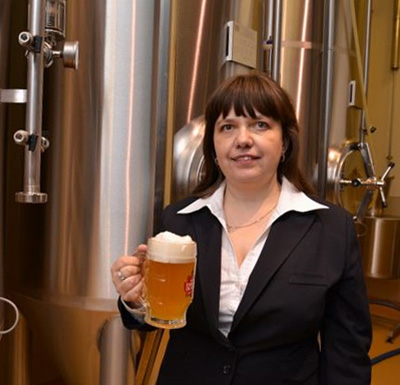
Monica Mandrutiu,
Member of the EBC Executive Team
Hi everybody,
My name is Monica Mandrutiu and I am the Quality Lead at Asahi Breweries Europe Group. An important part of my work lies in ensuring alignment with the regional and global quality strategy & standards and leading the quality improvement projects for eleven breweries across five countries in Central Europe.
I have been in brewing industry my entire career, starting 1990 at Ursus Breweries in Romania. I held various roles in brewing, quality and innovation on local and then at a regional level within the SABMiller Europe hub. Since 2017 I have been part of Asahi Breweries Europe Group technical hub. As such, I represent Asahi on the advisory board of the EBC, the so-called EBC Executive Team. Besides being professionally involved in brewing, I am an accredited beer sommelier (Beer Academy, UK) and member of the tasting panels of many key beer competitions in the world.
For me, the EBC represents an invaluable link between industry – both the brewing industry and allied support via suppliers – as well as brewing technologists employed at institutes and tertiary institutions of higher learning and research. One of the prime platforms for developments in brewing science remains the EBC congress. This issue of the EBC newsletter contains information and trends observed at the recently held EBC congress in Antwerp. There is also interesting news on the activities of the EBC Analysis Group, a new chairman for the EBC Brewing Science Group and on the publications front. Happy reading!
EBC at work
EBC Executive Team
The EBC Executive Team met ahead of the 37th EBC Congress under the chairmanship of Benet Fité, the Vice-President of the EBC. The Executive Team discussed the final details of the EBC Congress such as the publication of the presentations and posters after the EBC Congress. They also welcomed the 1st updated “EBC Manual of Good Practice: beer filtration and stabilisation” and agreed to continue the series of update by working on the next one: “EBC Manual of Good Practice: Hops and Hop Products”. The EBC Executive Team will have its next meeting in September to develop the EBC Work Plan 2020 and to start the preparation for the next EBC Symposium and the next edition of the EBC Congress.
EBC Analysis Group
On the 1 and 2 June, more than 30 experts from breweries, malting companies, hop producers, institutes and universities met in Antwerp, ahead of the EBC Congress, to discuss the latest developments in the individual sub-committees and plan collaborative trials for developing new EBC Analytica Methods. Representatives of the Brewery Convention of Japan (BCOJ) and of the American Society of Brewing Chemists (ASBC) also participated and provided inputs for international collaborative trials. Insights are provided here below for each Sub-Committee.
Sub-Committee Microbiology
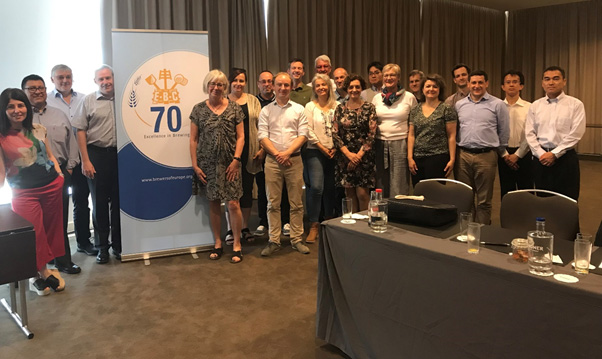
International Methods on the detection of Brettanomyces and on the detection of yeast, following collaborative trials organized by the ASBC and to which the EBC participated, are likely to be published by the end of 2019.
An update of EBC Method “4.2.5.1 – Cu Sulphate Method by introduction of control strains” is in the planning. Interested parties can contact the Chair of the Sub-Committee. The collaborative trial should start by the end of 2019 for publication of an updated method in 2020.
An International collaborative trial is in planning for 2020 on PCR detection. Interested parties can contact the Chair of the Sub-Committee (see box).
Call for Interest – collaborative trial
The Subcommitte Microbiology is seeking participating laboratories for a ring trial about the detection of contaminants with realtime PCR methods. The planned time schedule is a first round with 2-3 participants to set the final trial conditions, followed by the ring trial with 10-12 participating laboratories. First round is indended to start in Q4/2019, the ring trial will take place in Q1-2/2020.
Participating labs need the following skills and equipment: Capability to handle microliter pipets, ideally have a realtime PCR thermocycler in-house. Other small laboratory instruments as mini centrifuge, vortexer/shaker, and microliter pipettes are required. One or two labs can be substituted with a realtime PCR thermocycler instrument during the trial.
If you want to get more information, please contact either Mathieu Schneider at The Brewers of Europe mathieu@brewersofeurope.org , or the chair of the Subcommittee Microbiology Gudrun Vogeser vogeser@pika-weihenstephan.de.
Sub-Committee Barley & Malt
The Sub-Committee Barley & Malt will be starting a collaborative trial on a new method on the gushing potential of malt in Q4 2019 for a potential publication in 2020. The Sub-Committee is currently running a collaborative trial to update EBC Method 6.5 (Extract Content of Maize: Enzymatic Method). The results should be available in the next six months for a publication of the updated Method on BrewUp.
Sub-Committee Beer & Wort
The Sub-Committee Beer & Wort is currently organizing a collaborative trial on gluten analysis whose results could be available in 2020. The collaborative trial will start in September 2019 and any interested parties can flag their interest to the ad interim chair of the Sub-Committee. Another Method is in development concerning color determination by L.A.B. The related collaborative trial will start Q4 2019/Q1 2020.
Call for Interest – collaborative trial
Ladies and Gentleman,
EBC Analytica Beer & Wort Subcommittee is organizing 2 EBC collaborative trials for end of this year :
- gluten test
- L,a,b analysis.
Please find attached the 2 analytical protocols that have been prepared and reviewed by EBC Beer&Wort subcommittee.
The gluten test collaborative trial will take place in September on a couple of beer samples (protocol here).
The L,a,b analysis test collaborative trial will be organized around November, also on around 5 beer samples (protocol here).
The more there will be labs which participate the most effective will be the collaborative trials in order to publish EBC methods.
If you have the capabilities to perform the two analysis methods or at least one of them, it would be very appreciated that you join the volunteers to these collaborative trials.
If you are interested by participating to one or both of these collaborative test and/or if you have any questions related to the analysis protocols, please contact Sabine Koehl (sabine.koehl@kronenbourg.com).
Cheers,
EBC Wort & Beer Subcommittee
EBC Brewing Science Group
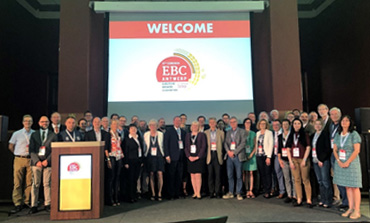
As is customary, the EBC Brewing Science Group meets during the EBC congress. Contrary to the biennial technical meeting, this is largely administrative.
 This year’s meeting was dominated by the quest for finding a replacement for Dr. Carsten Zufall (Cerveceria Polar, Venezuela) who had been the group’s chairman since 2012. One nomination was received, for Dr. Gert De Rouck, the pilot brewer at KU Leuven / Technology Campus Ghent. He was unanimously confirmed in the position.
This year’s meeting was dominated by the quest for finding a replacement for Dr. Carsten Zufall (Cerveceria Polar, Venezuela) who had been the group’s chairman since 2012. One nomination was received, for Dr. Gert De Rouck, the pilot brewer at KU Leuven / Technology Campus Ghent. He was unanimously confirmed in the position.
Sub-Committee Hops
Experts of the Sub-Committee Hops discussed the first statistical results of an international collaborative trial involving the BCOJ and the ASBC on the use of the EBC Method 9.47 (Iso-α-acids and reduced iso-α-acids (Rho, Tetra, Hexa) in beer by HPLC) in dry-hopped beer. As a follow-up to this trial, the EBC Methods 9.47 and 9.8 (Bitterness of Beer – International Method) are likely to be updated before the end of 2019. They would be made available on BrewUp.
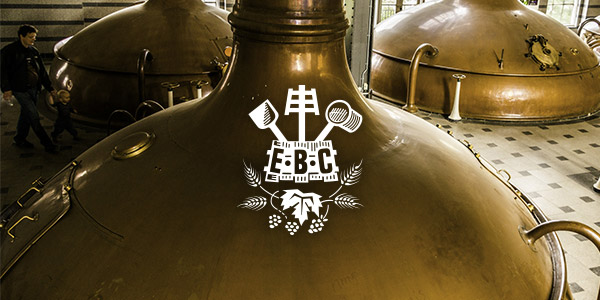
EBC news and publications
Manual of Good Practice – Beer filtration and stabilisation
Dr. Ulrich Balzer, a former technical manager at AB Inbev Deutschland (he worked at Beck’s in Bremen, as well as having been the former plant director of Diebels in Issum, NRW), was tasked 2 years ago with the updating of the Manual of Good Practice on beer filtration and stabilisation. The job has now been completed, the contents has been updated and the design brought in line with 21st century standards. We asked the author a few questions about this project:
Hi Ulrich! You’re the author of the update of the EBC Manual of Good Practice: beer filtration and stabilisation that was published earlier this month. Can you tell us what this updated edition means for our readers?
UB: In the first two chapters the purpose of filtration, stabilisation and cold sterile filtration as well as the required performance of these processes are defined. Then the principles of filtration using filter- aids are described. The chapter “filtration equipment” contains detailed descriptions of pre-coat- and crossflow filtration systems, including way of operation, process hygiene, utility consumption, maintenance, troubleshooting and operator safety. The chapter on “stabilisation in filter” outlines the principles of haze formation and stabilisation of beer with silica gel and PVPP using classical and newly developed systems. Additionally, in the chapter “particle, fine and final filtration” the principles of these processes as well as the design and operation of systems for these tasks are explained.
So this manual strives to give the reader an overview over the most important filtration, stabilisation and cold sterile filtration techniques, which are currently used in the brewing industry. It helps to get a deeper understanding of these processes, which can be useful for optimisation of existing plants and for making the best decision for new investments.
With the development of new technologies in the field of filtration and with the rise of new brewers and a continuously increasing palette of beer styles, how do you see the future of beer filtration evolve in the next ten years? Will it not ultimately lead to a regular update of this Manual?
UB: I think in the future breweries producing mainstream lagers and ales will tend to introduce crossflow filtration systems, if they have to invest in a new filtration plant. However, then they will have to focus more closely on raw material quality and processes upstream filtration like for example wort clarification and removal of beer solids during cold maturation, in order to avoid filtration problems. For brewers who want to experiment with different beer styles, especially if extremely dark beers are produced or if special raw materials like unmalted barley are being brewed with, I would recommend to use classical pre-coat filtration systems, because such systems afford more flexibility the the brewer to react to beers with different filterability.
In the coming years I do not expect a fundamental modification of beer filtration technology, like the introduction of CMF. However, classical systems like the horizontal leaf filter may disappear entirely and suppliers will wan to continue optimising existing systems. So, yes, a new update would probably make sense in about 8-10 years.
You attended The Brewers of Europe Forum 2018 in Brussels, where the EBC organised a Symposium on beer filtration. How much of the contents of the Symposium has filtered down into the updated Manual? And how did you enjoy the conversation there among brewers and technicians?
UB: Many of the ideas presented at the Symposium were introduced or adopted into the updated manual. Especially the podium discussion involving experts from breweries and filtration companies on the future of filtration was stimulating and highly interesting to all participants. Even more important for me was the fact that enough time was budgeted for to facilitate informal technical discussions among the delegates present at the symposium.
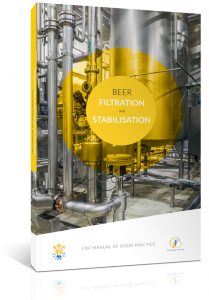 The updated “EBC Manual of Good Practice – Beer filtration and stabilisation” is now available for sale for 99€ (incl. VAT) at www.carllibri.com.
The updated “EBC Manual of Good Practice – Beer filtration and stabilisation” is now available for sale for 99€ (incl. VAT) at www.carllibri.com.
For more info, please check the BrewUp page dedicated to the EBC Manuals of Good Practice: https://brewup.eu/brew/manuals/beer-filtration
EBC Events
EBC Congress 2019
The EBC congress 2019 took place at the Flanders Meeting and Convention Centre in Antwerp, Belgium, in tandem with the associated Brewers Forum, from 2 – 6 June. Over 55 oral presentations were matched by over 130 posters, a near record bearing testimony to the attraction that the EBC congress still holds for brewing scientists and technologists as a platform for disseminating important research for the brewing technical fraternity. The technical programme was matched by a lively social programme with a visit to the De Koninck city brewery, an evening at the Horta events location and the Antwerpse Brouw Compagnie for the farewell party. At the farewell event, the per papers and best posters were cited ina prize-winning ceremony. The winning presentations are indicated in red below.
Posters
- P50: Dominique Dixius, Stefan Hanke, Georg Stettner, Annika Lagemann. Influence on beer bitter quality by using different hop products. Bitburger Braugruppe GmbH, Germany
- P65: Minami Umegatani, Nobuchika Takesue, Shizuka Asano, Kazuhiko Uemura. Study of beer-spoilage Lactobacillus nagelii harbouring hop resistance gene HORA. Asahi Breweries Ltd., Japan
- P82: Scott Lafontaine, Lindsey Rubottom, Thomas Shellhammer. “VACUPACK”- Whole hops packaged under an inert atmosphere. Oregon State University, USA
- P111: Charlotte De Schepper, Niels Langenaeken, Christophe Courtin. A frsh look at small and large starch granules in barley malt. KU Leuven
Papers
- L53: Ann Van Holle, Hilde Muylle, Tom Ruttink, Anita Van Landschoot, Geert Haesaert, Dirk Naudts, Denis De Keukeleire, Isabel Roldán-Ruiz. Genetic and biochemical approach to study the impact of terroir on the brewing value of hops. De Proefbrouwerij / Univ. Gent, Belgium
- L7: Mathias Hutzler, Tim Meier-Dörnberg, Fritz Jacob. Saccharomyces cerevisiae var. diastaticus – friend or foe? TUM Weihenstephan, Freising, Germany
- L11: Julien Billard, Sophie Schwebel, Romain Kapel, Marc Schmitt. Identification of factors at the origin of the phenomenon of beer gushing in order to develop a premature technique of the gushing risk. IFBM-Qualtech & Univ. of Lorraine, Nancy, France
- L19: Christina Dietz, David Cook, Ray Marriott, Colin Wilson, Rebecca Ford. Taking hop aroma apart: Supercritical CO2 fractionated oils offers new flaour possibilities for brewers. Univ. Nottingham, UK
- L20: Nils Rettberg, Laura Knoke, Julia Hildebrandt, Sarah Thörner, Jörg Maxminer. Exploring hop derived contributors to beer bitterness using data-independent acquisition (DIA). VLB Berlin, Germany
- L23: Jonas De Roos, Luc De Vuyst. Wooden barrels are an additional source of micro-organisms for lambic beer production. Vrije Universiteit Brussel, Belgium
The Brewers of Europe Forum 2020
The 3rd edition of The Brewers of Europe Forum will take place on 3 and 4 June 2020 in Brussels, at a convention centre located near the South Station, The EGG. Contrary to the event in 2018, there will be no accompanying EBC Symposium this time, as we have decided to support the Brewers Forum by offering a series of basic brewing lectures to appeal to the newcomers in the industry. The EBC Symposium plus EBC Brewing Science Technical Meeting is envisaged for September 2020 in Perugia (Italy), upon the kind invitation of the Italian Beer Research Centre (CERB) and the national association, AssoBirra. More information on both events will follow soon!


